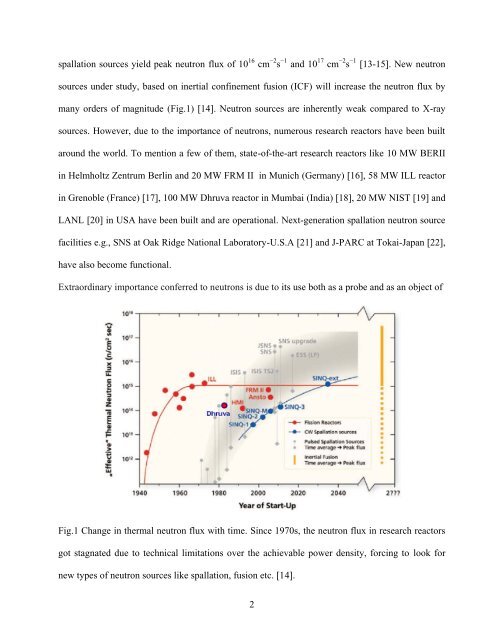PHYS01200804001 Sohrab Abbas - Homi Bhabha National Institute
PHYS01200804001 Sohrab Abbas - Homi Bhabha National Institute
PHYS01200804001 Sohrab Abbas - Homi Bhabha National Institute
Create successful ePaper yourself
Turn your PDF publications into a flip-book with our unique Google optimized e-Paper software.
spallation sources yield peak neutron flux of 10 16 cm −2 s −1 and 10 17 cm −2 s −1 [13-15]. New neutron<br />
sources under study, based on inertial confinement fusion (ICF) will increase the neutron flux by<br />
many orders of magnitude (Fig.1) [14]. Neutron sources are inherently weak compared to X-ray<br />
sources. However, due to the importance of neutrons, numerous research reactors have been built<br />
around the world. To mention a few of them, state-of-the-art research reactors like 10 MW BERII<br />
in Helmholtz Zentrum Berlin and 20 MW FRM II in Munich (Germany) [16], 58 MW ILL reactor<br />
in Grenoble (France) [17], 100 MW Dhruva reactor in Mumbai (India) [18], 20 MW NIST [19] and<br />
LANL [20] in USA have been built and are operational. Next-generation spallation neutron source<br />
facilities e.g., SNS at Oak Ridge <strong>National</strong> Laboratory-U.S.A [21] and J-PARC at Tokai-Japan [22],<br />
have also become functional.<br />
Extraordinary importance conferred to neutrons is due to its use both as a probe and as an object of<br />
Fig.1 Change in thermal neutron flux with time. Since 1970s, the neutron flux in research reactors<br />
got stagnated due to technical limitations over the achievable power density, forcing to look for<br />
new types of neutron sources like spallation, fusion etc. [14].<br />
2
















